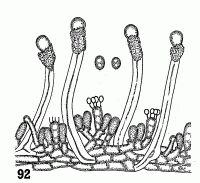|
 Tubulicrinis cinctus Tubulicrinis cinctus
BiostatusPresent in region - Indigenous. Endemic
Images (click to enlarge)
Caption: FIG. 92. Tubulicrinis cincta. Showing the cylindrical cystidia with expanded apices,
each bearing a collar of crystals beneath apices, capitate paraphysate hyphae, and oval
spores. |
Article: Cunningham, G.H. (1963). The Thelephoraceae of Australia and New Zealand. New Zealand Department of Scientific and Industrial Research, Bulletin 145: 359 p. Wellington:.
Description: Hymenophore annual, arachnoid, adherent, effused forming irregular colonies to 4 x 2.5
cm; hymenial surface white, or cream, velutinate, not creviced; margin thinning out,
white, arachnoid, adherent. Context to 50 µ thick, white, basal layer composed of a few
repent hyphae, intermediate layer a compact zone of mainly erect hyphae; generative
hyphae 4-6 µ diameter, walls 0.2 µ thick, naked, with clamp connections. Cystidia arising
from the base of the context, projecting for the greater part of their length, cylindrical, 56-90 x 6-8 µ,
apices inflated to 10 µ, walls smooth save beneath inflated regions there
bearing a band of coarse crystals, lumena capillary, save in inflated apical regions.
Hymenial layer a scanty palisade of basidia, paraphyses, cystidia, and a few paraphysate
hyphae. Basidia clavate, 12-16 x 5.5-6 µ, bearing 4 spores; sterigmata erect, slender, to 4
µ long. Paraphyses clavate, 10-14 x 4-5 µ. Paraphysate hyphae arising from the context,
projecting slightly, stems to 12 x 3 µ, capitate apices 4-5 µ diameter. Spores elliptical, 4-4.5 x
3-3.5 µ, walls smooth, hyaline, 0.1 µ thick.
Habitat: HABITAT: Effused on bark of dead branches.
Distribution: TYPE LOCALITY: Weheka, Westland, New Zealand.
DISTRIBUTION: New Zealand.
Notes: Cystidia are cylindrical, apices inflated, with girdling bands of crystals at bases of inflated
areas. Five species with inflated apices to the cystidia have been named, T. accedens (B. &
G.) Donk, `Peniophora' juniperina Bourd. & Galz., T. regifica (Jacks. & Deardn.) Donk,
T. sceptrifera (Jacks. & Were.) Donk and T. thermometra. T. cincta agrees most closely
with T. regifica and T. sceptrifera. It differs from the latter by the shape of the cystidia,
and from T. regifica by the smaller cystidia with bands of girdling crystals, and smaller
spores.
|